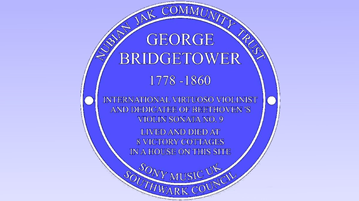Afro-European violinist and favourite of Beethoven remembered in Southwark
14 October 2022

Southwark Council celebrates virtuoso violinist, George Bridgetower, with a new heritage plaque at Jack Jones House, 12 Reedham Street, London. This is where he once lived, on what would have been his 244th birthday (11 October) and in what is now Black History Month.
Bridgetower’s mother and father were from Germany and Barbados. However, he was born in Poland in 1778. Bridgetower’s career took him all over the world, but he finally settled in Peckham, South London.
After demonstrating early talent, Bridgetower’s father took him on a tour of Europe, where his reputation as a gifted violinist was established.
Aged 10-years-old, Bridgetower was already a soloist at the Drury Lane Theatre, where he made such an impression that the Prince Regent, future King George IV, agreed to pay for his musical education.
George Bridgetower went on to travel and stun audiences across Europe. He met, and performed with Beethoven in Vienna, in 1803. At this time, Bridgetower was considered one of the greatest violinists to have lived.
Beethoven was so impressed that he dedicated his Violin Sonata No. 9 in A minor to Bridgetower. However, the two later fell out over a woman, causing Beethoven to rededicate Sonata No 9 to the violinist Rodolphe Kreutzer, who never played the piece, saying it was too complicated.
George Bridgetower had continued success and was elected to the Royal Society of Musicians. However, his fallout with Beethoven certainly affected his career.
George and his wife, Mary Leech Leake, were married in London in 1816 and later travelled between London and Italy, where their daughter lived. Mary died in 1835 and Bridgetower went on to live at 8 Victory Cottages in Peckham, until his death in 1860. George Bridgetower is buried in Kensal Green Cemetery.
In 1970, George and Mary’s house was demolished and a retirement home was later built on the site. Today it is called Jack Jones House, named in memory of the famous trade unionist who lived there. It is here that a plaque now marks Bridgetower’s great talent and achievements.
Southwark Council and Sony Music Entertainment sponsored the George Bridgetower plaque, working with the Nubian Jak Community Trust on its 77th London blue plaque.
Cllr Catherine Rose, Cabinet Member for Leisure, Parks, Streets a Clean Air, said: “We are delighted to support this wonderful plaque, marking the home of George and Mary Bridgetower. As an Afro-European musician performing in the 18th century, George will have endured significantly more challenges than many of his contemporaries. It is wonderful and important to learn more about his remarkable story and exceptional achievements.
“Thanks to Tara Gaynor for her championing of George Bridgetower, that led to the Nubian Jak Community Trust and Sony Music securing this fitting tribute to him, at the site of his final home, here in Peckham.
“George is in good company, as over the years many wonderful musicians of all nationalities have made a home here, in Southwark.
“I hope George’s story inspires and encourages local children of all backgrounds, to discover more about the achievements of the Black men and women, who have enriched music and culture throughout history.”
Jak Beula, CEO of the Nubian Jak Community Trust, said: “George Bridgetower, quite simply, is the greatest violin virtuoso this country has ever seen. His plaque will be music to the ears of those who have been calling for him to recognised and re-celebrated.”
Charlotte Edgeworth, Director of Diversity, Inclusion and Social Impact at Sony Music UK, said: “Sony Music UK is thrilled to support the creation of this plaque commemorating George Bridgetower, who had a profound influence on classical music. Bridgetower was a highly talented violinist whose career took him from playing solo at Drury Lane Theatre to performing alongside Beethoven in Vienna. We’re delighted he is getting appropriate recognition and hope to introduce him to a new audience with this blue heritage plaque at the house where he once lived.”
Page last updated: 14 October 2022
